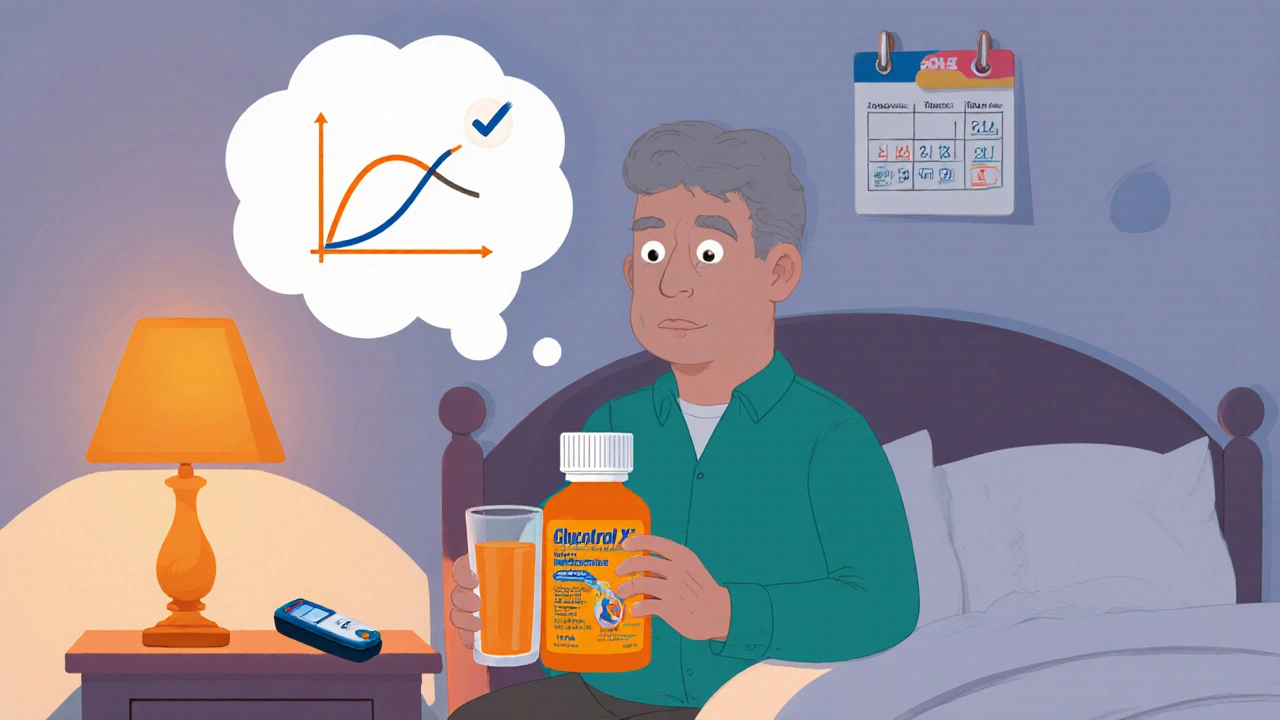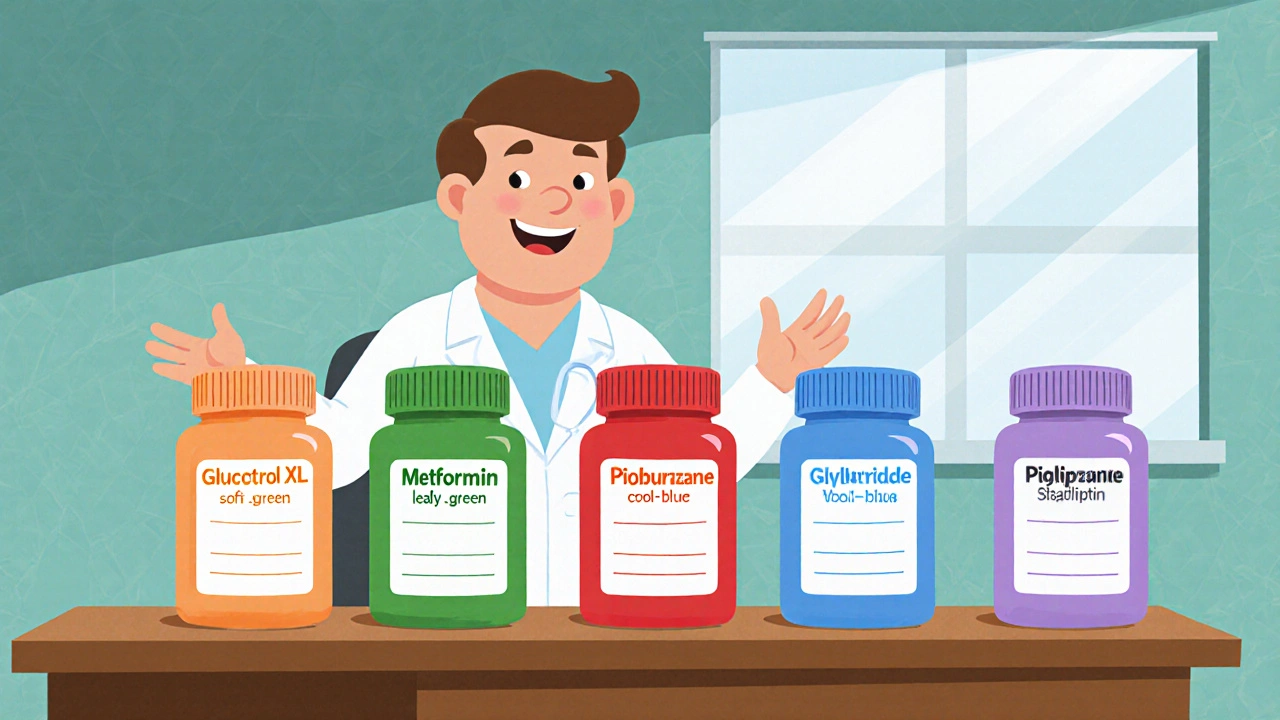Diabetes Medication Selector
Find the diabetes medication that best matches your priorities. Select what matters most to you and see which medications align with your goals.
Your Best Matches
Medication Recommendations
When your doctor prescribes a pill to keep blood sugar in check, you want to know exactly how it stacks up against the other options on the shelf. diabetes medication comparison isn’t just for specialists; it’s the everyday reality for anyone juggling doses, side effects, and insurance formularies. Below we break down Glucotrol XL (glipizide) side‑by‑side with the most common oral alternatives, so you can see where each one shines and where it falls short.
What is Glucotrol XL (Glipizide)?
Glucotrol XL is a long‑acting sulfonylurea that stimulates the pancreas to release more insulin. Its active ingredient, glipizide, works by binding to the SUR1 subunit of ATP‑sensitive potassium channels on beta cells, causing a rapid influx of calcium and a burst of insulin secretion. The extended‑release formulation allows once‑daily dosing, typically at bedtime, which can smooth out early‑morning glucose spikes.
Glucotrol XL is approved for type 2 diabetes in adults who need additional control beyond diet, exercise, or metformin alone. It’s taken with or without food, but patients should avoid skipping meals to reduce the risk of hypoglycemia.
Why Compare It With Other Oral Agents?
Choosing a medication isn’t just about potency; it’s about how the drug fits your lifestyle, budget, and health profile. Some people prioritize low cost, others look for the smallest chance of low blood sugar, while a third group worries about weight gain or cardiovascular impact. By laying out the key attributes of each class, you can match the drug to your personal goals.
Key Comparison Criteria
- Mechanism of action: How the drug lowers glucose.
- Typical dosage range: Starting and maximum doses.
- Effect on HbA1c: Average reduction seen in trials.
- Common side effects: What patients report most often.
- Weight impact: Gain, loss, or neutral.
- Hypoglycemia risk: How likely a low‑blood‑sugar episode is.
- Cost (US average retail): Approximate monthly price without insurance.
- Contraindications: Who should avoid the drug.
Side‑by‑Side Table
| Attribute | Glucotrol XL (Glipizide) | Metformin | Glyburide | Pioglitazone | Sitagliptin |
|---|---|---|---|---|---|
| Class | Sulfonylurea | Biguanide | Sulfonylurea | Thiazolidinedione | DPP‑4 inhibitor |
| Mechanism | Stimulates pancreatic insulin release | Decreases hepatic glucose production, improves peripheral insulin sensitivity | Stimulates insulin release (more potent) | Activates PPAR‑γ to increase insulin sensitivity | Blocks degradation of incretin hormones, enhancing insulin release |
| Typical dose | 5 mg - 10 mg daily (XL) | 500 mg - 2,000 mg daily (split) | 1.25 mg - 5 mg daily | 15 mg - 45 mg daily | 100 mg - 100 mg daily |
| HbA1c reduction | ≈1.0 % points | ≈1.1 % points | ≈1.2 % points | ≈0.6 % points | ≈0.5 % points |
| Weight effect | Neutral to slight gain | Neutral to modest loss | Potential gain | Modest gain | Weight neutral |
| Hypoglycemia risk | Moderate (especially with missed meals) | Low | High (long half‑life) | Low | Very low |
| Average monthly cost | $30 - $45 (generic) | $4 - $10 (generic) | $25 - $40 (generic) | $60 - $120 (brand) | $200 - $250 (brand) |
| Key contraindications | Severe liver disease, sulfonylurea allergy | Renal impairment (eGFR <30 mL/min) | Severe liver disease, heart failure | NYHA Class III/IV heart failure | Pancreatitis history |
When Glucotrol XL Makes Sense
If you’ve already tried metformin and need a second line that can be taken once a day, glipizide often fits the bill. Its relatively short half‑life compared to glyburide means hypoglycemia episodes tend to resolve faster. The drug works well for patients who have a regular eating schedule and can watch for early‑morning lows.
Insurance formularies frequently list generic glipizide as a low‑cost option, which can be a deciding factor for those on a tight budget. Because the medication is metabolized mainly by the liver, it’s a decent fallback for patients with moderate renal impairment who cannot stay on high‑dose metformin.
Scenarios Where Alternatives Are Better
Metformin is the go‑to first‑line drug for most newly diagnosed type 2 diabetics. It lowers liver glucose output, helps you lose a bit of weight, and carries a negligible hypoglycemia risk. If you’re overweight, have a family history of cardiovascular disease, or simply dislike the idea of a pill that can push your sugar too low, metformin usually wins.
Glyburide can be useful when a patient needs a very potent insulin‑secretagogue and can tolerate once‑daily dosing, but its long action increases the danger of overnight lows. Pioglitazone helps with insulin resistance but adds weight and can worsen heart failure, so it’s reserved for patients without cardiac issues who need a modest HbA1c drop.
Sitagliptin and other DPP‑4 inhibitors are popular for their gentle side‑effect profile. They’re pricey, though, and the glucose‑lowering effect is usually less dramatic than sulfonylureas. If you have a history of severe hypoglycemia or are on a medication regimen that makes low sugars dangerous (e.g., elderly with falls), a DPP‑4 inhibitor could be the safer bet.

Practical Tips for Switching or Adding Glucotrol XL
- Consult your clinician about baseline HbA1c, kidney and liver function, and any heart conditions.
- If you’re on metformin, a common plan is to start glipizide at 5 mg nightly while keeping metformin unchanged.
- Monitor fasting glucose for the first two weeks. If values dip below 70 mg/dL, adjust the dose or consider a lower‑strength tablet.
- Always have a quick source of glucose (fruit juice, glucose tablets) on hand, especially if you skip a meal.
- Schedule a follow‑up visit in 8-12 weeks to reassess HbA1c and discuss any side effects.
Remember, none of these medications cure diabetes; they help you keep blood sugar in a target range so you can avoid complications like neuropathy, retinopathy, or kidney disease.
Common Questions About Glucotrol XL
Can I take Glucotrol XL if I have kidney disease?
Glipizide is primarily cleared by the liver, so mild to moderate renal impairment is generally acceptable. Severe kidney disease (eGFR <30 mL/min) still warrants caution and close monitoring.
What should I do if I experience a hypoglycemic episode?
Consume 15-20 g of fast‑acting carbohydrate (like 4 oz of fruit juice or glucose tablets), recheck your blood sugar after 15 minutes, and repeat if it’s still below 70 mg/dL. Call your doctor if episodes happen often.
Is Glucotrol XL safe during pregnancy?
Sulfonylureas cross the placenta and are generally avoided in pregnancy. Insulin is the preferred therapy for gestational diabetes.
How does the cost of Glucotrol XL compare to brand‑name alternatives?
The generic version of glipizide typically costs $30-$45 per month, far less than brand‑only options like sitagliptin, which hover around $200 monthly.
Can I combine Glucotrol XL with other oral agents?
Yes, many clinicians pair a sulfonylurea with metformin to exploit two different mechanisms. The combination can improve HbA1c by about 1.5 % points, but it also raises the overall hypoglycemia risk.
Bottom Line
Glucotrol XL offers a convenient, low‑cost way to boost insulin secretion, and it works best for patients who can maintain regular meals and need a once‑daily pill. If you’re concerned about weight gain, low‑blood‑sugar episodes, or have heart failure, consider metformin, a DPP‑4 inhibitor, or a thiazolidinedione instead. The best choice always hinges on your personal health picture, insurance coverage, and how much monitoring you’re willing to do.

Sean Thomas
October 24, 2025
They've got the pharma giants pushing Glucotrol XL like it's the only answer, while the cheap generics get hidden under a mountain of red tape. The real reason they love sulfonylureas is they lock you into a cycle of doses and doctor visits. If you watch the fine print you’ll see the risk of hypoglycemia is down‑played to keep the market moving.